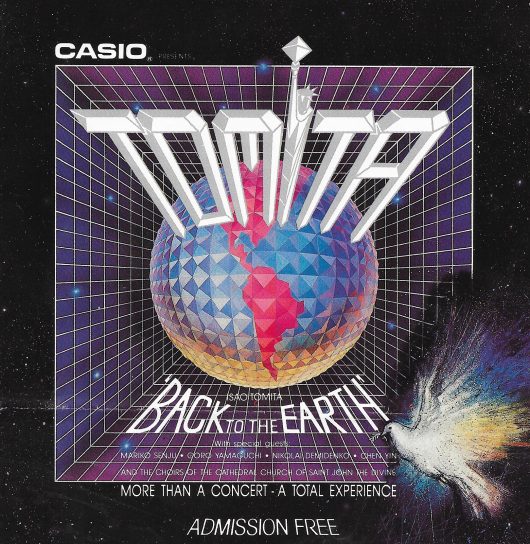
Isao Tomita in New York – 8th April 2020
or the tale of channel 101 –
In 1984 I was tasked by Theatre Projects to manage the lighting for a concert by Isao Tomita on the banks of the River Danube in Linz, the show went well and I made some new friends amongst the Japanese creative team.
A year later I was in Tokyo lighting a dance show for Wayne Sleep when I reached out to them and I was invited to dinner. When I arrived I was greeted by around twenty creatives and technicians from Tomita’s team and by the great Isao Tomita himself.
To give an indication of how well he was regarded in that part of the World on the flight out to Tokyo when I mentioned to a Cathay Pacific stewardess that I had worked with Tomita I was moved from the back of the plane to First Class, the food was superb!
Anyway as we sat down to dinner Tomita as host did the rounds with the wine waiter and poured everyone a glass of wine, he then sat down leaving the bottle between my place and his and his glass empty. Now did he not drink? Was I supposed to pour his drink? Time to step up to the plate as it were; I poured his drink, a smattering of applause and two weeks later they were back in touch.
On Saturday the 13th of September 1986 as the sun set over the Hudson River New York the residents of Manhattan were bemused to see the Japanese keyboard Maestro Isao Tomita being hoisted into the air in a large Perspex pyramid and left suspended forty feet above their heads.
The event was a free outdoor concert sponsored by CASIO and presented as a gift from the people of Japan to the people of America to celebrate the Centennial of the Statue of Liberty under the auspices of Mayor Edward.I.Koch. The concert attracted a live audience of around eighty thousand and Tomita fulfilled his desire to perform in front of all types and classes of inhabitant from bag ladies to the mega-rich. It was also filmed for broadcast on national TV.
 The brief to which we worked and probably achieved, with tongue firmly in cheek, was to make the event so spectacular that should any alien life form be watching our planet they would be able to see it and enjoy it as well. A pretty all-encompassing aspiration!
The brief to which we worked and probably achieved, with tongue firmly in cheek, was to make the event so spectacular that should any alien life form be watching our planet they would be able to see it and enjoy it as well. A pretty all-encompassing aspiration!
Tomita was suspended in his mirrored Pyramid from a crane placed on a large barge moored alongside Battery Park opposite the Statue of Liberty. He was encircled by eight main loudspeaker and lighting positions, four 10m x 10m x 10m towers on land in the park and four moored 300m off shore on barges in the Hudson River to create an octophonic sound system.
Tomita, as a young boy playing in a scrap yard became fascinated by the various different ways a single sound would reach him through the piles of metal. Here he recreated that phenomenon by using FM transmissions to each of the eight towers with slightly different delays and tonal mixes being sent to each source.
The performance was computer linked to a Master timing tape but was predominantly live from his keyboards and from the other Artists who guested during the concert.
The sound system was specified by the Japanese sound designer and was supplied by ShowCo I recall it was Very loud but as clear as a bell.
Other technical aspects of the one hundred and five minute show included a vast fireworks display launched from another barge 450m off shore, three high powered lasers on the river bank beaming graphics onto water and clouds and the lighting system designed by myself and Japanese LD Toshishige Fuyumuro.
The basic staging concept of the event is illustrated below
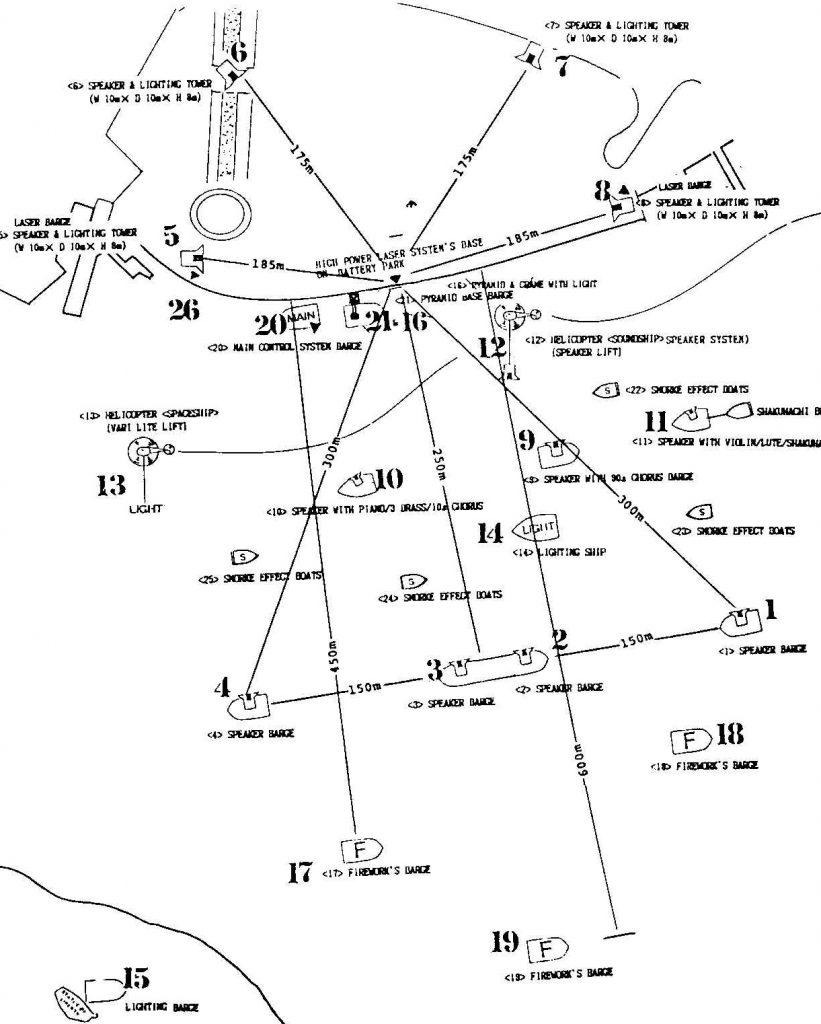

Each of the land based towers supported over one hundred par cans and Gladiator spots on top, each tower had its own generator and a twenty channel desk controlled by an operator at each tower, but more of that later….
The four river based sound barges carried a forty foot high scaffolding tower rigged with over one hundred pars with VNSP and ACL lamps, HMI pars and more Gladiators the central two towers were on one 400 foot long barge which also sported four Sky Tracker four head searchlights, again each tower had it’s own operator with the kit on the centre long barge being run from a 96 way Avo desk with more operators for the HMIs and Sky-Trackers.
We also had a helicopter that originally was to sport an underhung rig of Vari#Lites but once we learnt that the pilot needed to be able to drop the load in the river should he get into trouble that concept was pared back and we had more pars on a square truss shape that also carried speakers, amps and a generator. Other lighting elements that sailed past included a tug boat loaded with more ACL pars acting as a firebird with the beams of light as its wings.
During the show other guest artists sailed past as if spontaneously joining Tomita in his music these included and a Staten Island ferry carrying a 300 piece gospel choir and a 21 year old Russian pianist Nikolai Demidenko. Now this was Nikolai’s first time out of Russia and the spot ops had difficulty picking him up surrounded as he was at all times by four burly KGB minders.
We also had a piano ship and a poor 18 year old Japanese violinist who was towed at speed across the river whilst standing in a small row boat and smoke throughout the show was dispersed by speed boats.
Overall we had a pretty big rig which also included the lights around and under Tomita’s pyramid which were operated from our control shack below on another 96 way AVO and included some Strand Showchangers. We had initially specified Vari#Lites here as well but the lighting budget was badly affected by an unusual money draining factor, site insurances.
The challenges and costs of mounting a free show in a public park in New York swiftly became apparent. Permission was needed to halt all river traffic for the period of the show, to build any temporary structure over thirty feet, to run power cables in the park, to keep the only toilets open past 8 o’clock at night, etc, etc.
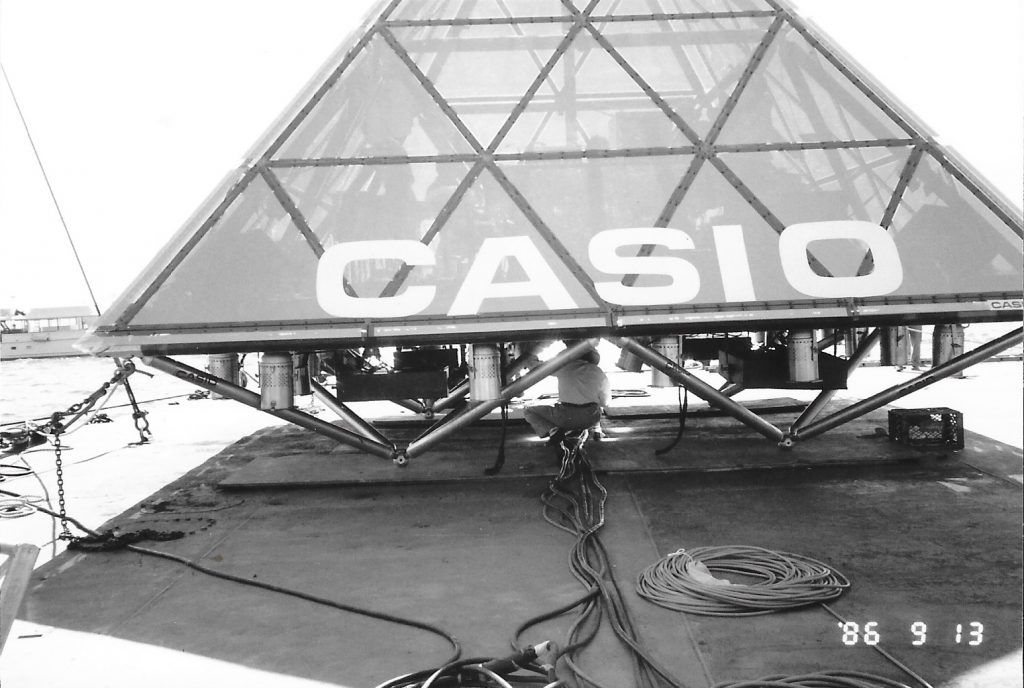
Below the pyramid we had a selection of pars and cyc floods and although Tomita wanted no direct light on him inside the Pyramid I had rigged four 500w floods at floor level so that the keyboard techs had some light to work with during rehearsals in darkness, numbered channel 101 but controlled by me on a small desk.
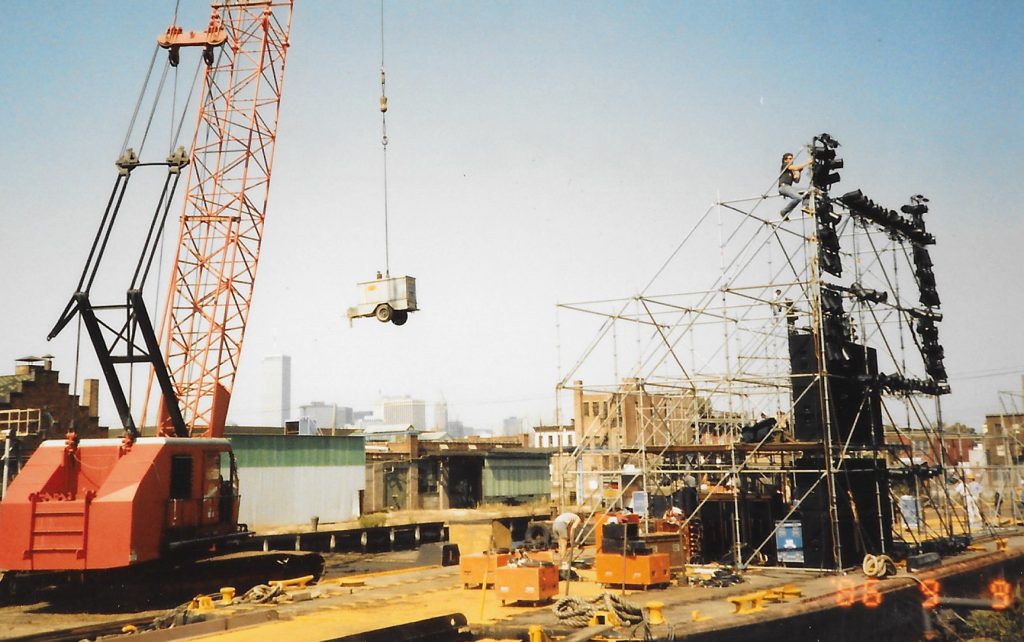
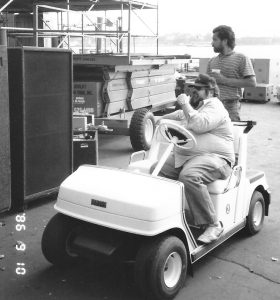
The lighting was supplied by See-Factor, remember the orange flight cases? One of their greatest challenges I recall was sourcing generators as one of New York’s sky-scrapers was having its electrical intake upgraded and had rented most of the available generators to power the building; the Great Bob See seen here in his company car.
I was to call the 213 cues that Toshi-San had put into the hour and three quarter show and with around thirty lighting and laser operators, most of whom could only be reached by radio, I got to thinking how this could possibly work.
I came up with the idea that our sponsors CASIO would supply all of our operators with a free stopwatch and I would write each operator a cue sheet with the exact times of their own cues. Tomita agreed that he would play a pre-show tone exactly ten second before he started the Master timing tape and I offset these 10 seconds on all the cue sheets. What could possibly go wrong?
Quite a lot as it turned out. Show time.
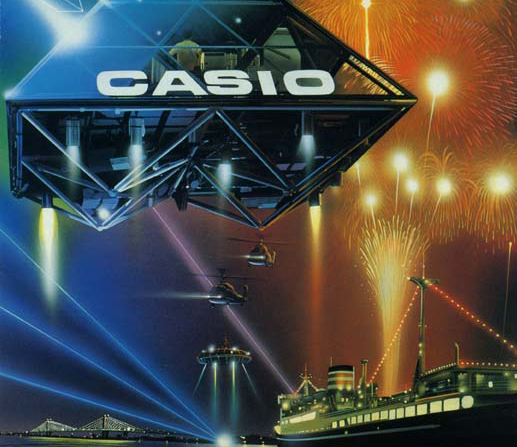
It became apparent that the crew should not have run the headset systems cable through the public space as the crowd was immense and soon trampled the aptly named ‘Kaos’ comms system to oblivion. All bank side communications were lost around five minutes before the show.
The radio system fared no better, if one operator transmitted during the show I could not transmit the cues and there was constant interference from taxis and police, during the complex Close Encounters sequence with the helicopter this police message drowned our system. “Tell unit 14 to hold fire as we are behind the building!” a little unnerving to say the least.Tomita had his own problems and having played the pre-show tone did not start the Master timing tape until twenty seconds later, Feck! Every cue taken on stop watch from my masterplan cue sheets would be 10 seconds late.
As the generators started to fail on some of the barges and the incoming radio traffic increased making it impossible to call any cues I looked over at my Japanese LD friend who was sat at his desk behind me with his coat over his head, there was only one course of action and I deployed channel 101.
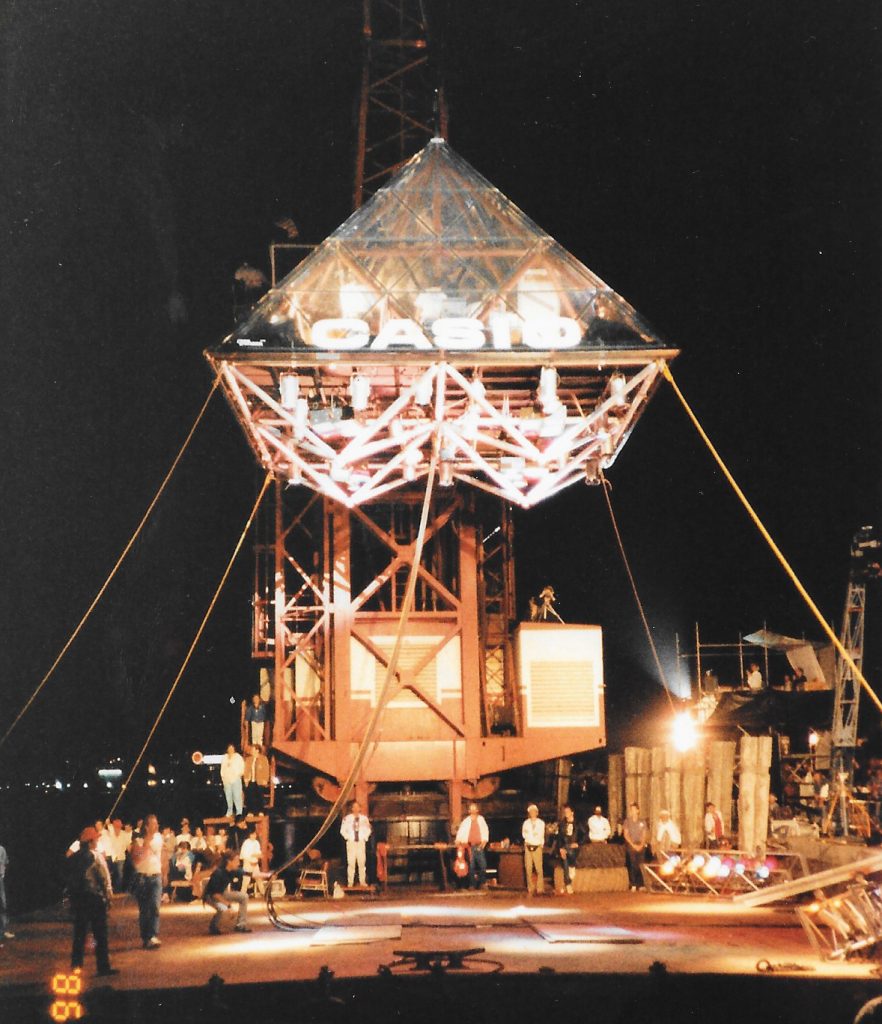
When I had focused the four floods of channel 101 inside the Pyramid one night I noticed that the internal reflections in the Perspex Pyramid made it impossible to see outside.
Now as is usual with such shows the only people who would notice any real lack of synchronicity would be the shows artistic team led in this case very much by Tomita. The audience both live and TV would only really notice the most obvious of mistakes and luckily the spot ops ignored the timings and did visual cues, the helicopter operator responded live to Tomtita’s tones whilst I was wondering which building was about to be shot up.
I could cue the main pyramid lighting by slapping the AVO desk op next to me on the back with a stick, it really was so loud that you could not speak to the guy next to you. All the amazing effects we had created were going off at some point and there were no real audience noticeable mistakes.
Of course in Toshi’s tidy mind it was all going to hell in a hand cart and completely beyond his control. The show however was a great success and as Tomita played the last chord, echoed by a few lighting cues still going off ten seconds late he descended to the deck to take the rapturous applause from his fans, and perhaps some aliens overhead!
Now Toshi spoke a little English but I called the translator over as it needed to be explained very clearly what I had done.
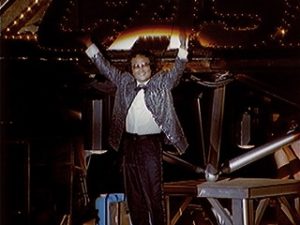
“Now that did not go as we had planned and hoped but everything we created was seen at some point during the show even if it did not accompany the music that it was intended for. The audience did not notice anything amiss and neither did Tomita as he could not see out of the Pyramid due to channel 101, also he was very much an eyes down musician anyway given the complexity of his kit. Go and take your applause Toshi-San the show was a great success and the lighting Spectacular!”
As this was translated a transformation came over my Japanese friend of many months, his back bone straightened, his shoulders pulled back and he nodded at me and marched down the barge to join his client and take his well deserved bow.
The Japanese creative team, who had hardly drunk a drop of alcohol during the lead up to the show, that night took over the top floor of our hotel and held a ‘bring a mini bar’ party. I vaguely remember through the haze of what turned out to be another all-nighter that I was sure I could make out a few disposable KODAK cameras floating in the plastic dustbin that was our punch bowl and into which the entire contents of our minibars had been emptied.
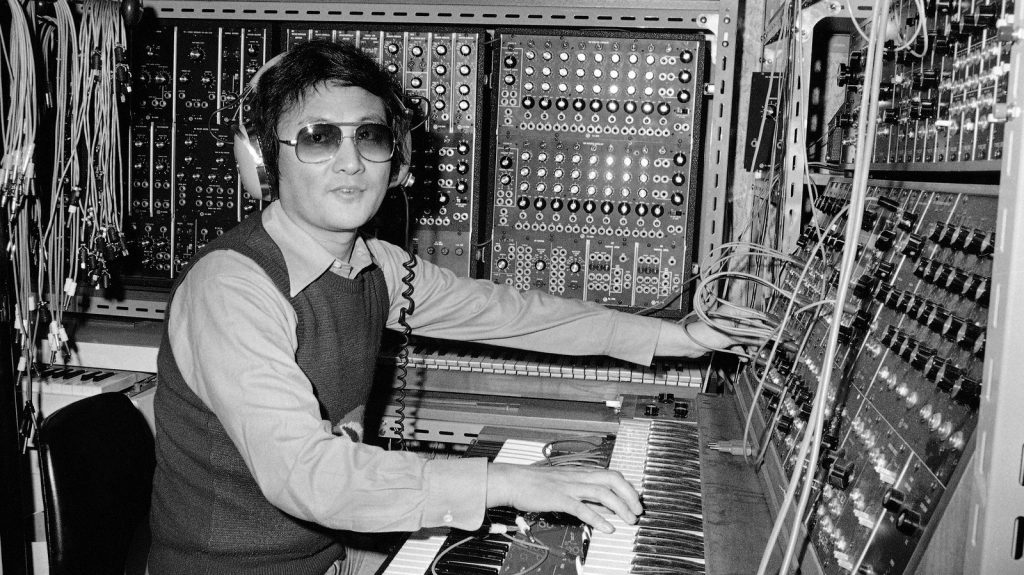
So what did I learn from this? The show was far too complicated with too many cues, Toshi-San was trying to Supersize what he normally did in a concert hall and it does not work. We created a monster that romped merrily all over us and it’s a lesson I’ve carried to this day; KISS, Keep It Simple Stupid.
Whilst I have tried to recall events as they happened it was over thirty years ago so for any inaccuracies, to paraphrase author John McKinna, I plead sanctuary in the cathedral of storytelling.
Team
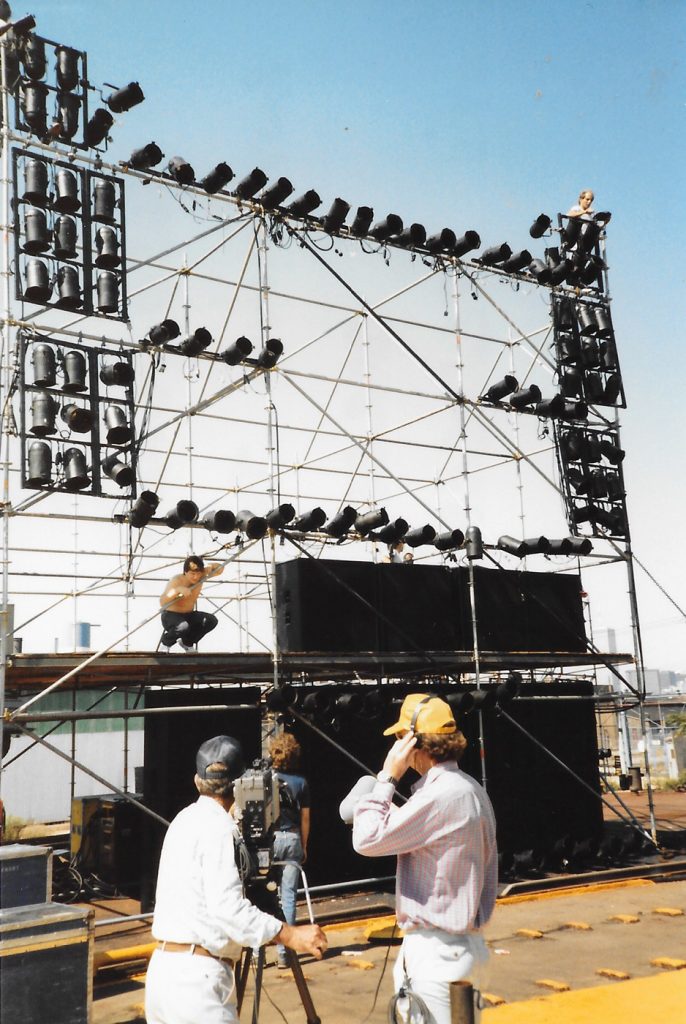
Producer: Danny O’Donovan
Director: Kohei Katsura
Production Manager: Michael Ahern
Lighting Design: Toshishige Fuyumuro, Durham Marenghi
Sound Design: Yamanaka-San
Fireworks Design: Seji Kase
Tech co-ordinator: Ken Lammers
Production LX for See Factor: Joe Travada
Crew Boss: Joe Batista
Main Equipment:
1042 VNSP or ACL Par Cans
4 x 4 head Skytrackers
8 x Gladiator Follow spots
12 x Strand Showchangers
28 x Prima Light curtains
6 x HMI Pars
32 x 2k Nook lights
2 x 96 way AVO desks
8 x 20 way 2 preset desks
Thirty Stop watches!